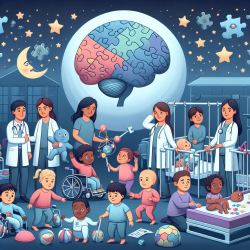Introduction
The recent publication titled "An atlas of white matter anatomy, its variability, and reproducibility based on constrained spherical deconvolution of diffusion MRI" provides a comprehensive overview of white matter (WM) anatomy using advanced imaging techniques. This research is pivotal for practitioners in speech-language pathology, particularly those involved in pediatric therapy, as it offers new insights into the neural pathways that underpin language and cognitive functions.
Understanding the Atlas
The study employs constrained spherical deconvolution (CSD) tractography to map 68 WM bundles, offering a detailed depiction of typical WM anatomy. This approach addresses the limitations of diffusion tensor imaging (DTI) by providing a more accurate representation of complex fiber structures. For practitioners, understanding these neural pathways is crucial for diagnosing and treating language disorders.
Applications in Speech-Language Pathology
For speech-language pathologists, particularly those working with children, the ability to visualize and understand WM pathways can enhance diagnostic accuracy and treatment planning. The atlas provides detailed maps of pathways such as the arcuate fasciculus, which is crucial for language processing. By integrating this knowledge into practice, therapists can better tailor interventions to the specific neural profiles of their clients.
Encouraging Further Research
The variability and reproducibility data provided in the atlas highlight the need for further research in clinical settings. Practitioners are encouraged to utilize these findings to explore how WM variability might impact language development and disorders. This could lead to more personalized therapy approaches and improved outcomes for children with speech and language challenges.
Practical Implementation
- Integrate WM atlas data into clinical assessments to enhance understanding of language-related neural pathways.
- Use the atlas as a reference for developing targeted therapy plans that consider individual neural profiles.
- Collaborate with neuroimaging specialists to incorporate advanced imaging techniques in routine practice.
Conclusion
The white matter atlas provides a valuable resource for speech-language pathologists aiming to enhance their practice through data-driven decisions. By understanding the neural underpinnings of language, practitioners can offer more effective, personalized interventions. To explore the full research paper, please follow this link: An atlas of white matter anatomy, its variability, and reproducibility based on constrained spherical deconvolution of diffusion MRI.










